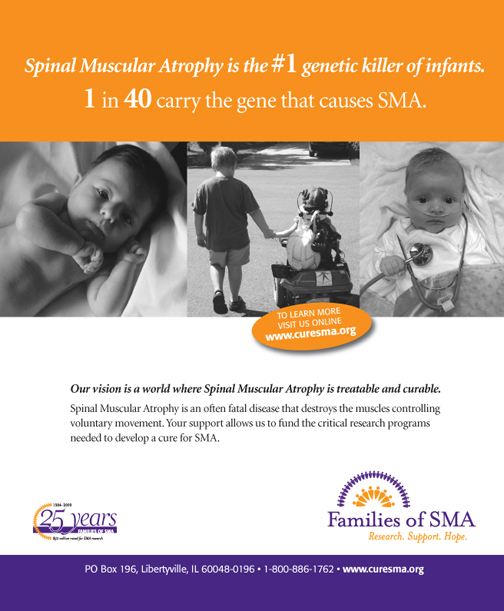Do You Know What SMA Stands For? You Should! Quick Facts About SMA You Should Know!
 Kourtney Rose Marie Kozack, SMA Type One Patient
Kourtney Rose Marie Kozack, SMA Type One Patient
August is SMA Awareness month when we all try to increase awareness of this devastating disease. Help these beautiful children in the fight of their life.
Spinal Muscular Atrophy (SMA) the number one genetic killer of children under the age of two, is an often fatal disease that destroys the nerves controlling voluntary muscle movement, which affects crawling, walking, head and neck control, and
even swallowing.
WHO IS AFFECTED? SMA is one of the most prevalent genetic disorders.
• One in every 6,000 babies is born with SMA.
• SMA can strike anyone of any age, race or gender.
• One in every 40 people carries the gene that causes SMA. The child of two carriers has a one in four chance of developing SMA.
• 7.5 million Americans are carriers.
THE TYPES OF SMA
Autosomal recessive is the mode of genetic transmission for SMA. This means that two copies of the gene are needed in order for the disease’s traits to be inherited. In other words, one copy from each parent. SMA patients are classified into four types based on milestones achieved at the onset of SMA. Types 1and 2 are the most prevalent.
Type I, or Werdnig-Hoffmann Disease, is the most severe form of SMA. Type I SMA strikes infants between birth and six months old. Children affected with Type I cannot sit without support.
Type II affects infants between seven and 18 months old. Type II patients may be able to sit unaided or even stand with support. They are at increased risk for complications from respiratory infections.
Type III, also known as Kugelberg-Welander Disease, is the least deadly form of childhood-onset SMA. It strikes children as early as the age of 18 months, but can surface as late as adolescence. Type III patients are able to walk, but weakness is prevalent. Most patients eventually need to use a wheelchair.
Type IV is the adult form of the disease. Symptoms tend to begin after age 35.
SMA does not affect sensation and intellectual activity in patients. It commonly is observed that patients with SMA are unusually bright and sociable.
A NOTE FROM THE FAMILIES OF SMA:
The diagnosis of Spinal Muscular Atrophy can be scary and frustrating, running the gamut of emotions… but you are not alone. You are now part of Families of SMA, a network of families, researchers, clinicians and other professionals who are determined to make a difference.
If you know someone who has been recently diagnosed with SMA, please e-mail [email protected] to request a free informational packet, or call 1-800-886-1762


